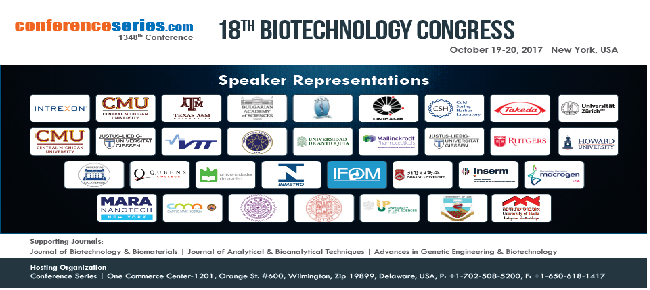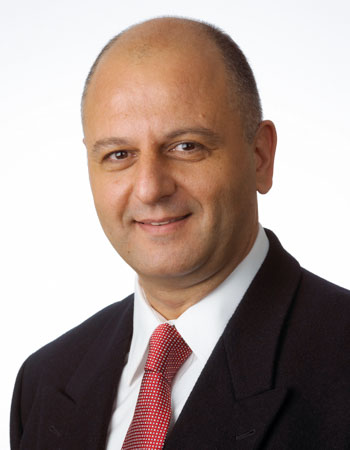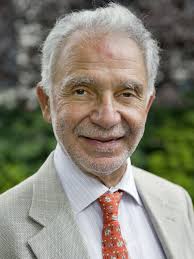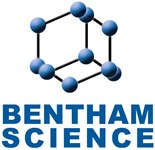Theme: Novel Insights & Innovations in Biotechnology for Leading a Better Life
Bio America 2017
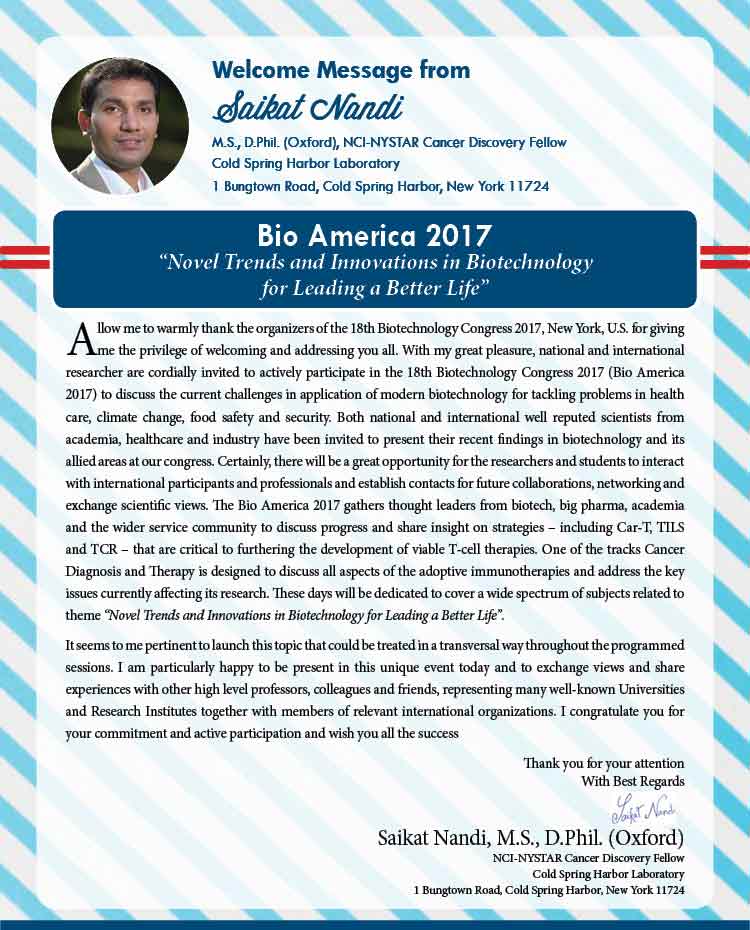
Allow me to warmly thank the organizers of the 18th Biotechnology Congress 2017, New York, U.S. for giving me the privilege of welcoming and addressing you all. With my great pleasure, national and international researcher are cordially invited to actively participate in the 18th Biotechnology Congress 2017 (Bio America 2017) to discuss the current challenges in application of modern biotechnology for tackling problems in health care, climate change, food safety and security. Both national and international well reputed scientists from academia, healthcare and industry have been invited to present their recent findings in biotechnology and its allied areas at our congress. Certainly, there will be a great opportunity for the researchers and students to interact with international participants and professionals and establish contacts for future collaborations, networking and exchange scientific views. The Bio America 2017 gathers thought leaders from biotech, big pharma, academia and the wider service community to discuss progress and share insight on strategies – including Car-T, TILS and TCR – that are critical to furthering the development of viable T-cell therapies, aging and Neuroscience. For this one of the tracks Cancer Diagnosis and Therapy is designed to discuss all aspects of the adoptive immunotherapies and address the key issues currently affecting its research. These days will be dedicated to cover a wide spectrum of subjects related to theme “Novel Trends and Innovations in Biotechnology for Leading a Better Life”.
It seems to me pertinent to launch this topic that could be treated in a transversal way throughout the programmed sessions. I am particularly happy to be present in this unique event today and to exchange views and share experiences with other high level professors, colleagues and friends, representing many well-known Universities and Research Institutes together with members of relevant international organizations. I congratulate you for your commitment and active participation and wish you all the success.
Thank you for your attention.
With Best Regards,

Saikat Nandi, M.S., D.Phil. (Oxford),
NCI-NYSTAR Cancer Discovery Fellow
Cold Spring Harbor Laboratory
1 Bungtown Road, Cold Spring Harbor, New York 11724
Importance and scope:
Biotechnology is multi-disciplinary subject which use of living organisms and Engineering principles to develop or make products, or "any technological application that uses biological systems, living organisms, or derivatives thereof, to make or modify products or processes for specific use" (UN Convention on Biological Diversity, Art. 2). Biotechnology has applications in industrial areas, including health care (medical), Bio pharmaceutical industries, crop production and agriculture, non food (industrial) uses of crops and other products (e.g. vegetable oil, biofuels), and environmental uses. Growing demand for food for increasing population, ever increasing vaccination demand for people with affordable cost, solving inherited genetic diseases, to decrease global temperature by using bio-fertilizers which non emitting GHGs, leading life of the people with better life, can achieved with the help of biotechnology. So scope of biotechnology is very wide and it touches the every walk of life. By considering potentiality of growing technology in down-stream and up-stream processing in biopharma, genetic engineering, Tissue and protein engineering, fermentation technology and relevant fields, the sharing of thoughts and brain storming is necessary for contemporary developments in biotechnology research.
Target Audience:
Target Audience for Biotechnology congress will be personnel from both industrial and academic fields which include; Directors/Managers, Head of Departmental, Presidents/Vice Presidents, CEO, Professors, Associate and Assistant professors, Research Scholars and students from the related fields.
Target Audience
Industry 40%
Academia 50%
Others 10%
Conference Highlights:
· Medicine & Biotechnology
· Medical Biotechnology
· Biomedical Engineering and Bio-Engineering
· Pharmaceutical Biotechnology
· Genetic Engineering and Tissue Engineering
· Enzyme and Protein Engineering
· Nanobiotechnology
· Plant, Agriculture and Environment Biotechnology
· Marine, Aquatic and Ocean Biotechnology
· Food & Feed Biotechnology
· Animal Biotechnology
· Bioinformatics and Biomedicine Engineering
· Industrial and Microbial Biotechnology
· Applied Biotechnology
· Bio-Safety and Bioethics
· Business Development
Major Biotechnology Associations around the Globe:
· American Society for Biochemistry and Molecular Biology
· American Society of Gene Therapy
· European Federation of Biotechnology
· American Genetic Association
· Biotechnology and Biological Research Council (UK)
· European Association of Pharma Biotechnology
Track 1: Medicine & Biotechnology
From manipulation of mutant genes to enhanced resistance to disease, biotechnology has allowed advances in medicine. Biotechnology is used in medicinal field such as Pharmacogenomics, Genetic Diagnosis and Gene Therapy. The study of pharmacogenomics can result in the development of tailor-made vaccines for people, more accurate means of determining drug dosages, improvements in drug discovery and approval, and the development of safer vaccines. Modern biotechnology can be used to manufacture drugs more easily and cheaply, as they can be produced in larger quantities from existing genetic sources. Genetic diagnosis involves the process of testing for suspected genetic defects before administering treatment through genetic testing. In gene therapy, a good gene is introduced at a random location in the genome to aid the cure of a disease that is caused by a mutated gene.
Related Conferences
Annual Summit on Cell Therapy September 27-28, 2017, Chicago, Illinois, USA; Annual Summit on Cell Signaling and Cancer Therapy September 27-28, 2017, Chicago, Illinois, USA; 8th World Congress and Expo on Cell & Stem Cell Research March 20-22, 2017 Orlando, Florida, USA; 3rd International Conference & Exhibition on Tissue Preservation and Biobanking August 23-24, 2017 San Francisco, California, USA; 9th International Convention on Stem Cell and Biobanking October 23-24, 2017 Osaka, Japan; 3rd International Conference on Biotechnology and Agriculture Engineering Mar 28-30, 2017, Osaka, Japan; 8th International Conference on Food Engineering and Biotechnology Apr 24-26, 2017 Kuala Lumpur, Malaysia; National Biotechnology Conference, May 1-3, 2017, San diego, USA; 7th International Conference on Bioscience, Biochemistry, Bioinformatics Jan 21-23, 2017, Bangkok, Thailand; Global Biotechnology Congress 2017, July 10-13, Boston, USA; The European Forum for Industrial Biotechnology and Bio economy Oct 19-20,2017 , Brussels, Belgium; 14th Asia Pacific Biotechnology Congress July 20-22, 2017 , Melbourne, Australia.
Track 2: Medical Biotechnology
Medical Biotechnology or Red Biotechnology is the use of living cells and cell materials to research and produce pharmaceutical and diagnostic products that help and prevent human diseases. Applications in pharmacology, gene therapy, stem cells, Tissue engineering. By discovering new drugs and vaccines, there have been improved and accelerated drug testing, better diagnostic capabilities, and the availability of foods which enhance nutritional values. It has applications in manufacture pharmaceuticals like enzymes, antibiotics and vaccines, and its use for molecular diagnostic. Today, the availability of “targeted therapies” for diseases and individuals should greatly improve drug safety and efficacy, and the development of predictive technologies may lead to a new era in disease prevention, especially in some of the world’s fast developing economies. This sound rationale holds great potential and promise in the field of medical biotechnology.
Related Conferences
Annual Summit on Cell Therapy September 27-28, 2017, Chicago, Illinois, USA; Annual Summit on Cell Signaling and Cancer Therapy September 27-28, 2017, Chicago, Illinois, USA; 8th World Congress and Expo on Cell & Stem Cell Research March 20-22, 2017 Orlando, Florida, USA; 3rd International Conference & Exhibition on Tissue Preservation and Biobanking August 23-24, 2017 San Francisco, California, USA; 9th International Convention on Stem Cell and Biobanking October 23-24, 2017 Osaka, Japan; 3rd International Conference on Biotechnology and Agriculture Engineering Mar 28-30, 2017, Osaka, Japan; 8th International Conference on Food Engineering and Biotechnology Apr 24-26, 2017 Kuala Lumpur, Malaysia; National Biotechnology Conference, May 1-3, 2017, San diego, USA; 7th International Conference on Bioscience, Biochemistry, Bioinformatics Jan 21-23, 2017, Bangkok, Thailand; Global Biotechnology Congress 2017, July 10-13, Boston, USA; The European Forum for Industrial Biotechnology and Bio economy Oct 19-20,2017 , Brussels, Belgium; 14th Asia Pacific Biotechnology Congress July 20-22, 2017 , Melbourne, Australia.
Track 3: Biomedical Engineering and Bio-Engineering
Biomedical engineering is the multydisplinary subject which uses engineering principles and techniques to the medical field. This field seeks to close the gap between engineering and medicine.It combines the Principles and problem solving skills of engineering with medical and biological sciences to improve healthcare diagnosis and treatment. This is evident throughout healthcare, from diagnosis and analysis to treatment, care, and recovery, and has entered the public domain though the multiplication of implantable medical devices, such as pacemakers and artificial hips, to more state of the art technologies such as stem cell engineering and the 3-D printing of biological organs. Biomedical engineering focuses on the advances that improve human health and health care at all levels. There are potentialities in industry for innovating, designing, and developing new technologies; in academia furthering research and pushing the frontiers of what is medically possible as well as implementing, testing and developing new diagnostic tools and medical equipment; and in government for establishing safety standards for medical devices.
Related Conferences
Annual Summit on Cell Therapy September 27-28, 2017, Chicago, Illinois, USA; Annual Summit on Cell Signaling and Cancer Therapy September 27-28, 2017, Chicago, Illinois, USA; 8th World Congress and Expo on Cell & Stem Cell Research March 20-22, 2017 Orlando, Florida, USA; 3rd International Conference & Exhibition on Tissue Preservation and Biobanking August 23-24, 2017 San Francisco, California, USA; 9th International Convention on Stem Cell and Biobanking October 23-24, 2017 Osaka, Japan; 3rd International Conference on Biotechnology and Agriculture Engineering Mar 28-30, 2017, Osaka, Japan; 8th International Conference on Food Engineering and Biotechnology Apr 24-26, 2017 Kuala Lumpur, Malaysia; National Biotechnology Conference, May 1-3, 2017, San diego, USA; 7th International Conference on Bioscience, Biochemistry, Bioinformatics Jan 21-23, 2017, Bangkok, Thailand; Global Biotechnology Congress 2017, July 10-13, Boston, USA; The European Forum for Industrial Biotechnology and Bio economy Oct 19-20,2017 , Brussels, Belgium; 14th Asia Pacific Biotechnology Congress July 20-22, 2017 , Melbourne, Australia.
Track 4: Pharmaceutical Biotechnology
Pharmaceutical biotechnology is a comparatively new and growing field in which the principles of biotechnology are applied to the designing and production of drugs. Pharmaceutical companies manufacture and market drugs, livestock feed supplements, vitamins, and a host of other products. Consistently, Pharmaceutical companies are one of the most profitable industries in the U.S. with sales exceeding $320 billion per year. The Biotechnology industry uses modern technologies in genetics research to develop products for human diseases, includes companies engaged in drug discovery and research, production and biologically engineered food production. Biotech opportunities largely mirror those in the pharmaceutical industry yet this industry is still in its’ infancy stage developmentally. A majority of therapeutic drugs in the current market are bioformulations, such as antibodies, nucleic acid products and vaccines. Such bioformulations are developed through several stages that include: understanding the principles involed in health and disease; the fundamental molecular mechanisms governing the function of related biomolecules; production and purification of the molecules; determining the product shelf life, stability, toxicity and immunogenicity; drug delivery systems; patenting; and clinical trials. The future of bio-pharmaceuticals belongs to protein based therapeutics. Designing stable and effective therapeutic proteins requires knowledge of protein structure and the interactions that stabilise the structure necessary for function.
Related Conferences
Annual Summit on Cell Therapy September 27-28, 2017, Chicago, Illinois, USA; Annual Summit on Cell Signaling and Cancer Therapy September 27-28, 2017, Chicago, Illinois, USA; 8th World Congress and Expo on Cell & Stem Cell Research March 20-22, 2017 Orlando, Florida, USA; 3rd International Conference & Exhibition on Tissue Preservation and Biobanking August 23-24, 2017 San Francisco, California, USA; 9th International Convention on Stem Cell and Biobanking October 23-24, 2017 Osaka, Japan; 3rd International Conference on Biotechnology and Agriculture Engineering Mar 28-30, 2017, Osaka, Japan; 8th International Conference on Food Engineering and Biotechnology Apr 24-26, 2017 Kuala Lumpur, Malaysia; National Biotechnology Conference, May 1-3, 2017, San diego, USA; 7th International Conference on Bioscience, Biochemistry, Bioinformatics Jan 21-23, 2017, Bangkok, Thailand; Global Biotechnology Congress 2017, July 10-13, Boston, USA; The European Forum for Industrial Biotechnology and Bio economy Oct 19-20,2017 , Brussels, Belgium; 14th Asia Pacific Biotechnology Congress July 20-22, 2017 , Melbourne, Australia.
Track 5: Genetic Engineering and Tissue Engineering
Genetic engineering is the manipulation of an organism's genome using biotechnology Principles. It is a set of technologies used to change the genetic makeup of cells, including the transfer of genes within and across species domains for the production of improved or novel organisms. Genetic engineering has applications in medicine, research, industry and agriculture and can be used on a wide range of plants, animals and micro organisms. Tissue engineering is the use of a integration of cells, engineering and materials principles, and suitable biochemical and physicochemical factors to improve or replace biological tissues. It involves the use of a scaffold for the formation of new viable tissue for a medical purpose. Tissue engineering cover a broad range of applications, that repair or replace portions of or whole tissues (i.e., bone, cartilage, blood vessels, bladder, skin, muscle etc.). The definition of regenerative medicine is often used same sense with tissue engineering, although those involved in regenerative medicine place more emphasis on the use of stem cells or progenitor cells to produce tissues.
Related Conferences
Annual Summit on Cell Therapy September 27-28, 2017, Chicago, Illinois, USA; Annual Summit on Cell Signaling and Cancer Therapy September 27-28, 2017, Chicago, Illinois, USA; 8th World Congress and Expo on Cell & Stem Cell Research March 20-22, 2017 Orlando, Florida, USA; 3rd International Conference & Exhibition on Tissue Preservation and Biobanking August 23-24, 2017 San Francisco, California, USA; 9th International Convention on Stem Cell and Biobanking October 23-24, 2017 Osaka, Japan; 3rd International Conference on Biotechnology and Agriculture Engineering Mar 28-30, 2017, Osaka, Japan; 8th International Conference on Food Engineering and Biotechnology Apr 24-26, 2017 Kuala Lumpur, Malaysia; National Biotechnology Conference, May 1-3, 2017, San diego, USA; 7th International Conference on Bioscience, Biochemistry, Bioinformatics Jan 21-23, 2017, Bangkok, Thailand; Global Biotechnology Congress 2017, July 10-13, Boston, USA; The European Forum for Industrial Biotechnology and Bio economy Oct 19-20,2017 , Brussels, Belgium; 14th Asia Pacific Biotechnology Congress July 20-22, 2017 , Melbourne, Australia.
Track 6 : Enzyme and Protein Engineering
Protein engineering is the synthesis proteins by manipulation of sructure and process of developing useful or valuable proteins. It is a new discipline, with much research taking place into the understanding of protein folding, structure and recognition for protein design principles. It is also a product and services market, with an estimated value of $178 billion by 2018. In the future, more detailed knowledge of protein structure, folding and function, as well as advancements in modern technology, may greatly expand the potentiality of protein engineering. Eventually, even unnatural amino acids may be incorporated, owning to a new method that allows the inclusion of novel amino acids in the genetic code. Proteins have important role in physiological processes and they are involved in movement, recognition, catalysis, regulation etc. Moreover, proteins also have several therapeutical and industrial applications. Enzyme engineering is the modifying an enzyme's structure (and, thus, its function) or modifying the catalytic activity of enzymes to produce new metabolites, to allow new (catalyzed) pathways for reactions to occur, or to convert certain compounds into others (biotransformation). These products are useful as chemicals, pharmaceuticals, fuel, food industries, or agricultural additives. In the future, enzymes may be restructured to fit more appropriately into industrial processes for the production of desired metabolites.
Related Conferences
Annual Summit on Cell Therapy September 27-28, 2017, Chicago, Illinois, USA; Annual Summit on Cell Signaling and Cancer Therapy September 27-28, 2017, Chicago, Illinois, USA; 8th World Congress and Expo on Cell & Stem Cell Research March 20-22, 2017 Orlando, Florida, USA; 3rd International Conference & Exhibition on Tissue Preservation and Biobanking August 23-24, 2017 San Francisco, California, USA; 9th International Convention on Stem Cell and Biobanking October 23-24, 2017 Osaka, Japan; 3rd International Conference on Biotechnology and Agriculture Engineering Mar 28-30, 2017, Osaka, Japan; 8th International Conference on Food Engineering and Biotechnology Apr 24-26, 2017 Kuala Lumpur, Malaysia; National Biotechnology Conference, May 1-3, 2017, San diego, USA; 7th International Conference on Bioscience, Biochemistry, Bioinformatics Jan 21-23, 2017, Bangkok, Thailand; Global Biotechnology Congress 2017, July 10-13, Boston, USA; The European Forum for Industrial Biotechnology and Bio economy Oct 19-20,2017 , Brussels, Belgium; 14th Asia Pacific Biotechnology Congress July 20-22, 2017 , Melbourne, Australia.
Track 7: Nanobiotechnology
Nanobiotechnology is the multidisciplinary subject which combines engineering principles and molecular biology. Nanobiotechnology has the potentiality to create biological and biochemical materials and devices at molecular and atomic levels. It presents new class of multifunctional systems and devices for biological analysis with better sensitivity and much specificity. Nanobiotechnology subsumes the application of the tools and processes of nanotechnology to control biological systems. The nanobiotechnology includes new techniques such as 3D imaging in live cells, real-time imaging, and single molecule imaging bioanalytical microarrays and biosensors and microfluidic devices. This discipline helps to indicate the subsume of biological research with various fields of nanotechnology. Concepts that are enhanced through nanobiology comprises: nanodevices (such as biological machines), nanoparticles, and nanoscale phenomena that available within the discipline of nanotechnology. This technical approach to biology allows scientists to envisage and create systems that can be used for biological research. Biologically inspired nanotechnology uses biological systems as the encourisation for technologies not yet created. However, as with nanotechnology and biotechnology, bionanotechnology does have many potential ethical issues associated with it.
Related Conferences
Annual Summit on Cell Therapy September 27-28, 2017, Chicago, Illinois, USA; Annual Summit on Cell Signaling and Cancer Therapy September 27-28, 2017, Chicago, Illinois, USA; 8th World Congress and Expo on Cell & Stem Cell Research March 20-22, 2017 Orlando, Florida, USA; 3rd International Conference & Exhibition on Tissue Preservation and Biobanking August 23-24, 2017 San Francisco, California, USA; 9th International Convention on Stem Cell and Biobanking October 23-24, 2017 Osaka, Japan; 3rd International Conference on Biotechnology and Agriculture Engineering Mar 28-30, 2017, Osaka, Japan; 8th International Conference on Food Engineering and Biotechnology Apr 24-26, 2017 Kuala Lumpur, Malaysia; National Biotechnology Conference, May 1-3, 2017, San diego, USA; 7th International Conference on Bioscience, Biochemistry, Bioinformatics Jan 21-23, 2017, Bangkok, Thailand; Global Biotechnology Congress 2017, July 10-13, Boston, USA; The European Forum for Industrial Biotechnology and Bio economy Oct 19-20,2017 , Brussels, Belgium; 14th Asia Pacific Biotechnology Congress July 20-22, 2017 , Melbourne, Australia.
Track 8: Plant, Agriculture and Environment Biotechnology
Agricultural biotechnology, also known as agritech, is an area of agricultural science involving the use of scientific tools and techniques, including genetic engineering, molecular markers, molecular diagnostics, vaccines, and tissue culture, to modify living organisms: plants, animals, and microorganisms. Biotechnology is used in many ways in agriculture. Agricultural biotechnology companies work to supply farmers with tools to increase the yield of plant and animal products, while lowering the costs of production. Agricultural biotechnology can also include production of plants such as orchids for ornamental purposes and plants that can be used for fuel production (biofuels). To accomplish these goals, biotechnologists develop products to protect animals and crops from disease and help farmers identify the best animals and seeds to use in selective breeding programs. Environmental biotechnology is a system of scientific and engineering knowledge related to the use of microorganisms and their products in the prevention of environmental pollution through biotreatment of solid, liquid, and gaseous wastes, bioremediation of polluted environments, and biomonitoring of environment and treatment processes. The International Society for Environmental Biotechnology defines environmental biotechnology as "the development, use and regulation of biological systems for remediation of contaminated environments (land, air, water), and for environment-friendly processes (green manufacturing technologies and sustainable development)". Science through the IAASTD has called for the advancement of small-scale agro-ecological farming systems and technology in order to achieve food security, climate change mitigation, climate change adaptation and the realisation of the Millennium Development Goals. Environmental biotechnology has been shown to play a significant role in agroecology in the form of zero waste agriculture and most significantly through the operation of over 15 million biogas digesters worldwide.
Related Conferences
Annual Summit on Cell Therapy September 27-28, 2017, Chicago, Illinois, USA; Annual Summit on Cell Signaling and Cancer Therapy September 27-28, 2017, Chicago, Illinois, USA; 8th World Congress and Expo on Cell & Stem Cell Research March 20-22, 2017 Orlando, Florida, USA; 3rd International Conference & Exhibition on Tissue Preservation and Biobanking August 23-24, 2017 San Francisco, California, USA; 9th International Convention on Stem Cell and Biobanking October 23-24, 2017 Osaka, Japan; 3rd International Conference on Biotechnology and Agriculture Engineering Mar 28-30, 2017, Osaka, Japan; 8th International Conference on Food Engineering and Biotechnology Apr 24-26, 2017 Kuala Lumpur, Malaysia; National Biotechnology Conference, May 1-3, 2017, San diego, USA; 7th International Conference on Bioscience, Biochemistry, Bioinformatics Jan 21-23, 2017, Bangkok, Thailand; Global Biotechnology Congress 2017, July 10-13, Boston, USA; The European Forum for Industrial Biotechnology and Bio economy Oct 19-20,2017 , Brussels, Belgium; 14th Asia Pacific Biotechnology Congress July 20-22, 2017 , Melbourne, Australia.
Track 9: Marine, Aquatic and Ocean Biotechnology
The ocean has the oldest, most diverse, most numerous and least studied organisms on earth. It covers almost three fourths of our planet and has the potential to feed the world and supply cures for many diseases. Studying sea plants and animals is a challenge that is becoming easier due to advanced technologies such as deep-sea submersibles, sonar, lasers, videos, and satellites. Biotechnology contributes to current or potential uses of marine products in the areas of: Aquaculture, Conservation of marine ecosystems Therapeutics/medicines, Aquatic animal health and seafood safety, Biomedical research Algae cultivation. Marine Biotechnology is a relatively new field of study, having emerged in the past few years. It began in 1998 when scientists from the Scripps Institution of Oceanography and various departments of the University of California, San Diego, came together and formed the Center for Marine Biotechnology and Biomedicine. The Specialty Marine Biotechnology is intended to host scientific contributions in marine science that are based on the enormous biodiversity of marine ecosystems and the genetic uniqueness of marine organisms to develop useful products and applications. Marine Biotechnology is the study of how the various organisms and actions of the ocean can be used to provide services and products to us. Marine Biotechnology is the use of living marine resources at (eco)system, concept, organism or molecular level to provide beneficial solutions for the society. Scientists in this field of Marine Biotechnology are studying the various enzymes and proteins of marine life in hopes of solving many problems that plague the area of Agriculture and Industry today. These problems include trying to find anti-corrosive coatings and "self-cleaning" surfaces for industrial use.
Related Conferences
Annual Summit on Cell Therapy September 27-28, 2017, Chicago, Illinois, USA; Annual Summit on Cell Signaling and Cancer Therapy September 27-28, 2017, Chicago, Illinois, USA; 8th World Congress and Expo on Cell & Stem Cell Research March 20-22, 2017 Orlando, Florida, USA; 3rd International Conference & Exhibition on Tissue Preservation and Biobanking August 23-24, 2017 San Francisco, California, USA; 9th International Convention on Stem Cell and Biobanking October 23-24, 2017 Osaka, Japan; 3rd International Conference on Biotechnology and Agriculture Engineering Mar 28-30, 2017, Osaka, Japan; 8th International Conference on Food Engineering and Biotechnology Apr 24-26, 2017 Kuala Lumpur, Malaysia; National Biotechnology Conference, May 1-3, 2017, San diego, USA; 7th International Conference on Bioscience, Biochemistry, Bioinformatics Jan 21-23, 2017, Bangkok, Thailand; Global Biotechnology Congress 2017, July 10-13, Boston, USA; The European Forum for Industrial Biotechnology and Bio economy Oct 19-20,2017 , Brussels, Belgium; 14th Asia Pacific Biotechnology Congress July 20-22, 2017 , Melbourne, Australia.
Track 10: Food & Feed Biotechnology
Food biotechnology is the application of technology to modify genes of animals, plants, and microorganisms to create new species which have desired production, marketing, or nutrition related properties. Genetically engineered (GE) or genetically modified (GM) foods, they are a source of an unresolved controversy over the uncertainty of their long-term effects on humans and food chains. Food biotechnology is and will continue to be an important area in science as the world’s human population continues to increase and the world’s agricultural lands continue to decrease. Food biotechnology employs the tools of modern genetics to enhance beneficial traits of plants, animals, and microorganisms for food production. It involves adding or extracting select genes to achieve desired traits. Food biotechnology offers the potential to further improve our nation’s health and the health of developing nations. The work currently being done with “golden rice” and the potential it has to help combat hunger and malnutrition related diseases. Purchase fruits and vegetables with increased antioxidant content that may reduce risk for cancer. Plant-made pharmaceuticals are the latest evolution within the realm of biotechnology. As the name suggests, this process uses genetics to enable plants to produce protein-based medicines to treat diseases and save lives. These proteins are extracted from the plant and developed into pharmaceuticals. Edible vaccines are among the most innovative approaches for administering new vaccines. For example, researchers have investigated putting a vaccine into bananas that would protect against food borne pathogens.
Related Conferences
Annual Summit on Cell Therapy September 27-28, 2017, Chicago, Illinois, USA; Annual Summit on Cell Signaling and Cancer Therapy September 27-28, 2017, Chicago, Illinois, USA; 8th World Congress and Expo on Cell & Stem Cell Research March 20-22, 2017 Orlando, Florida, USA; 3rd International Conference & Exhibition on Tissue Preservation and Biobanking August 23-24, 2017 San Francisco, California, USA; 9th International Convention on Stem Cell and Biobanking October 23-24, 2017 Osaka, Japan; 3rd International Conference on Biotechnology and Agriculture Engineering Mar 28-30, 2017, Osaka, Japan; 8th International Conference on Food Engineering and Biotechnology Apr 24-26, 2017 Kuala Lumpur, Malaysia; National Biotechnology Conference, May 1-3, 2017, San diego, USA; 7th International Conference on Bioscience, Biochemistry, Bioinformatics Jan 21-23, 2017, Bangkok, Thailand; Global Biotechnology Congress 2017, July 10-13, Boston, USA; The European Forum for Industrial Biotechnology and Bio economy Oct 19-20,2017 , Brussels, Belgium; 14th Asia Pacific Biotechnology Congress July 20-22, 2017 , Melbourne, Australia.
Track 11: Animal Biotechnology
Animal biotechnology is a branch of biotechnology in which molecular biology techniques are used to genetically engineer (i.e. modify the genome of) animals in order to improve their suitability for pharmaceutical, agricultural or industrial applications. Animal biotechnology has been used to produce genetically modified animals that synthesize therapeutic proteins, have improved growth rates or are resistant to disease. Animal health and efficiency in generating animal based products with a target to increase quantity as well as quality of such products is the ultimate motive behind scientific research. Animal biotechnology is the use of science and engineering to modify living organisms. The goal is to make products, to improve animals and to develop microorganisms for specific agricultural uses. Examples of animal biotechnology include creating transgenic animals (animals with one or more genes introduced by human intervention), using gene knock out technology to make animals with a specific inactivated gene and producing nearly identical animals by somatic cell nuclear transfer (or cloning). Animal biotechnology in use today is based on the science of genetic engineering. Under the umbrella of genetic engineering exist other technologies, such as transgenics and cloning, that also are used in animal biotechnology. The potential benefits of animal biotechnology are numerous and include enhanced nutritional content of food for human consumption; a more abundant, cheaper and varied food supply; agricultural land-use savings; a decrease in the number of animals needed for the food supply; improved health of animals and humans; development of new, low-cost disease treatments for humans; and increased understanding of human disease.
Related Conferences
Annual Summit on Cell Therapy September 27-28, 2017, Chicago, Illinois, USA; Annual Summit on Cell Signaling and Cancer Therapy September 27-28, 2017, Chicago, Illinois, USA; 8th World Congress and Expo on Cell & Stem Cell Research March 20-22, 2017 Orlando, Florida, USA; 3rd International Conference & Exhibition on Tissue Preservation and Biobanking August 23-24, 2017 San Francisco, California, USA; 9th International Convention on Stem Cell and Biobanking October 23-24, 2017 Osaka, Japan; 3rd International Conference on Biotechnology and Agriculture Engineering Mar 28-30, 2017, Osaka, Japan; 8th International Conference on Food Engineering and Biotechnology Apr 24-26, 2017 Kuala Lumpur, Malaysia; National Biotechnology Conference, May 1-3, 2017, San diego, USA; 7th International Conference on Bioscience, Biochemistry, Bioinformatics Jan 21-23, 2017, Bangkok, Thailand; Global Biotechnology Congress 2017, July 10-13, Boston, USA; The European Forum for Industrial Biotechnology and Bio economy Oct 19-20,2017 , Brussels, Belgium; 14th Asia Pacific Biotechnology Congress July 20-22, 2017 , Melbourne, Australia.
Track 12: Bioinformatics and Biomedicine Engineering
Bioinformatics is an interdisciplinary field that develops methods and software tools for understanding biological data. As an interdisciplinary field of science, bioinformatics combines computer science, statistics, mathematics, and engineering to analyze and interpret biological data. Bioinformatics has been used for in silico analyses of biological queries using mathematical and statistical techniques. "All aspects of gathering, storing, handling, analyzing, interpreting and spreading vast amounts of biological information in databases”. The information involved includes gene sequences, biological activity/function, pharmacological activity, biological structure, molecular structure, protein-protein interactions, and gene expression. Bioinformatics uses powerful computers and statistical techniques to accomplish research objectives, for example, to discover a new pharmaceutical or herbicide." Deals with the computational management and analysis of biological information: genes, genomes, proteins, cells, ecological systems, medical information, robots, artificial intelligence. Areas of current and future development of bioinformatics are Molecular biology and genetics, Phylogenetic and evolutionary sciences, different aspects of biotechnology including pharmaceutical and microbiological industries, Medicine, Agriculture, Eco-management.
Related Conferences
Annual Summit on Cell Therapy September 27-28, 2017, Chicago, Illinois, USA; Annual Summit on Cell Signaling and Cancer Therapy September 27-28, 2017, Chicago, Illinois, USA; 8th World Congress and Expo on Cell & Stem Cell Research March 20-22, 2017 Orlando, Florida, USA; 3rd International Conference & Exhibition on Tissue Preservation and Biobanking August 23-24, 2017 San Francisco, California, USA; 9th International Convention on Stem Cell and Biobanking October 23-24, 2017 Osaka, Japan; 3rd International Conference on Biotechnology and Agriculture Engineering Mar 28-30, 2017, Osaka, Japan; 8th International Conference on Food Engineering and Biotechnology Apr 24-26, 2017 Kuala Lumpur, Malaysia; National Biotechnology Conference, May 1-3, 2017, San diego, USA; 7th International Conference on Bioscience, Biochemistry, Bioinformatics Jan 21-23, 2017, Bangkok, Thailand; Global Biotechnology Congress 2017, July 10-13, Boston, USA; The European Forum for Industrial Biotechnology and Bio economy Oct 19-20,2017 , Brussels, Belgium; 14th Asia Pacific Biotechnology Congress July 20-22, 2017 , Melbourne, Australia.
Track 13: Industrial and Microbial Biotechnology
Industrial biotechnology is a set of practices that use living cells (such as bacteria, yeast, algae) or component of cells like enzymes, to generate industrial products and processes. Industrial biotechnology can be used to: Create new products, such as plant-based biodegradable plastics; Replace petroleum-based feedstocks by processing biomass in biorefineries to produce electricity, transport fuels or chemicals; Modify and develop new industrial processes, such as by using enzymes to reduce the amount of harsh chemicals used the textile or pulp and paper industries; Reduce the environmental impact of manufacturing; for example by treating industrial wastewater onsite using biological mediums such as microbes; Industrial biotechnology is one of the most promising new approaches to pollution prevention, resource conservation, and cost reduction. It is often referred to as the third wave in biotechnology. If developed to its full potential, industrial biotechnology may have a larger impact on the world than health care and agricultural biotechnology. It offers businesses a way to reduce costs and create new markets while protecting the environment. Also, since many of its products do not require the lengthy review times that drug products must undergo, it's a quicker, easier pathway to the market. Today, new industrial processes can be taken from lab study to commercial application in two to five years, compared to up to a decade for drugs.
Related Conferences
Annual Summit on Cell Therapy September 27-28, 2017, Chicago, Illinois, USA; Annual Summit on Cell Signaling and Cancer Therapy September 27-28, 2017, Chicago, Illinois, USA; 8th World Congress and Expo on Cell & Stem Cell Research March 20-22, 2017 Orlando, Florida, USA; 3rd International Conference & Exhibition on Tissue Preservation and Biobanking August 23-24, 2017 San Francisco, California, USA; 9th International Convention on Stem Cell and Biobanking October 23-24, 2017 Osaka, Japan; 3rd International Conference on Biotechnology and Agriculture Engineering Mar 28-30, 2017, Osaka, Japan; 8th International Conference on Food Engineering and Biotechnology Apr 24-26, 2017 Kuala Lumpur, Malaysia; National Biotechnology Conference, May 1-3, 2017, San diego, USA; 7th International Conference on Bioscience, Biochemistry, Bioinformatics Jan 21-23, 2017, Bangkok, Thailand; Global Biotechnology Congress 2017, July 10-13, Boston, USA; The European Forum for Industrial Biotechnology and Bio economy Oct 19-20,2017 , Brussels, Belgium; 14th Asia Pacific Biotechnology Congress July 20-22, 2017 , Melbourne, Australia.
Track 14: Applied Biotechnology
The applied biotechnology major deals with the scientific background and laboratory experience necessary for the biotechnology and pharmaceutical industries, or for advanced study in the applications of biotechnology and molecular biology for the use and improvement of plants, animals, and micro-organisms. In addition, it can be to prepare for professional programs in medicine. Multi discipline science of interest in chemistry, biotechnology, microbiology. This interdisciplinary major brings together areas of study such as animals, food science, forestry, entomology, and plants to improve the knowledge and skills necessary to use biotechnology for the improvement of plants, animals, and microorganisms. Gaining theoretical as well as hands-on knowledge in the areas of molecular biology, structural biology and biotechnology furthermore, studies in the areas of protein engineering, synthetic biology and molecular biotechnology for renewable energy. Thanks to the courses in project management, marketing and entrepreneurship, one will also gain insight into business management and learn how projects are planned and carried out in the biotechnology industry.
Related Conferences
Annual Summit on Cell Therapy September 27-28, 2017, Chicago, Illinois, USA; Annual Summit on Cell Signaling and Cancer Therapy September 27-28, 2017, Chicago, Illinois, USA; 8th World Congress and Expo on Cell & Stem Cell Research March 20-22, 2017 Orlando, Florida, USA; 3rd International Conference & Exhibition on Tissue Preservation and Biobanking August 23-24, 2017 San Francisco, California, USA; 9th International Convention on Stem Cell and Biobanking October 23-24, 2017 Osaka, Japan; 3rd International Conference on Biotechnology and Agriculture Engineering Mar 28-30, 2017, Osaka, Japan; 8th International Conference on Food Engineering and Biotechnology Apr 24-26, 2017 Kuala Lumpur, Malaysia; National Biotechnology Conference, May 1-3, 2017, San diego, USA; 7th International Conference on Bioscience, Biochemistry, Bioinformatics Jan 21-23, 2017, Bangkok, Thailand; Global Biotechnology Congress 2017, July 10-13, Boston, USA; The European Forum for Industrial Biotechnology and Bio economy Oct 19-20,2017 , Brussels, Belgium; 14th Asia Pacific Biotechnology Congress July 20-22, 2017 , Melbourne, Australia.
Track 15 Bio-Safety and Bioethics
Biosafety as currently discussed in the International “Convention on Biological Diversity” (CBD) and designed to create internationally binding protocols on biosafety. The application of biotechnology to food and agriculture can bring not only potential risks and benefits as any technology can, but also concerns about the human dimensions coupled with biotechnology. These include both positive and negative impacts on stake holders, social institutions, economy and communities. Different areas associated with biosafety include: (i) Agriculture and food system issues (ii) Market and consumer issues (iii) Institutional issues, business issues and (iv) Social issues. Biosafety is the prevention of large-scale loss of biological integrity, focusing both on ecology and human health. These prevention mechanisms include conduction of regular reviews of the biosafety in laboratory settings, as well as strict guidelines to follow. The international Cartagena Protocol on Biosafety deals primarily with the agricultural definition but many advocacy groups seek to expand it to include post-genetic threats: new molecules, artificial life forms, and even robots which may compete directly in the natural food chain. ‘Biosafety’ means the need to protect human and animal health and environment from the possible adverse effects of the products of modern biotechnology. Bioethics is the study of the typically controversial ethical issues emerging from new situations and possibilities brought about by advances in biology and medicine. It is also moral discernment as it relates to medical policy and practice. Bioethicists are concerned with the ethical questions that arise in the relationships among life sciences, biotechnology, medicine, politics, law, and philosophy. The scope of bioethics can expand with biotechnology, including cloning, gene therapy, life extension, human genetic engineering, astroethics and life in space, and manipulation of basic biology through altered DNA, XNA and proteins. These developments will affect future evolution, and may require new principles that address life at its core, such as biotic ethics that values life itself at its basic biological processes and structures, and seeks their propagation.
Related Conferences
Annual Summit on Cell Therapy September 27-28, 2017, Chicago, Illinois, USA; Annual Summit on Cell Signaling and Cancer Therapy September 27-28, 2017, Chicago, Illinois, USA; 8th World Congress and Expo on Cell & Stem Cell Research March 20-22, 2017 Orlando, Florida, USA; 3rd International Conference & Exhibition on Tissue Preservation and Biobanking August 23-24, 2017 San Francisco, California, USA; 9th International Convention on Stem Cell and Biobanking October 23-24, 2017 Osaka, Japan; 3rd International Conference on Biotechnology and Agriculture Engineering Mar 28-30, 2017, Osaka, Japan; 8th International Conference on Food Engineering and Biotechnology Apr 24-26, 2017 Kuala Lumpur, Malaysia; National Biotechnology Conference, May 1-3, 2017, San diego, USA; 7th International Conference on Bioscience, Biochemistry, Bioinformatics Jan 21-23, 2017, Bangkok, Thailand; Global Biotechnology Congress 2017, July 10-13, Boston, USA; The European Forum for Industrial Biotechnology and Bio economy Oct 19-20,2017 , Brussels, Belgium; 14th Asia Pacific Biotechnology Congress July 20-22, 2017 , Melbourne, Australia.
Track 16 Business Development
Business Development referred as the activity of pursuing strategic opportunities for a particular business or organization, for example by cultivating partnerships or other commercial relationships, or identifying new markets for its products or services. Business development activities extend across different departments, including sales, marketing, project management, product management and vendor management. Networking, negotiations, partnerships, and cost-savings efforts are also involved. All these different departments and activities are driven by and aligned to the business development goals.
In the simplest terms, business development can be summarized as the ideas, initiatives and activities aimed towards making a business better. This includes increasing revenues, growth in terms of business expansion, and increasing profitability by building strategic partnerships, and making strategic business decisions. Business development activities extend across different departments, including sales, marketing, project management, product management and vendor management. Networking, negotiations, partnerships, and cost-savings efforts are also involved. All these different departments and activities are driven by and aligned to the business development goals. Since business development involves high-level decision making, the business developer should remain informed about current state of the business in terms of SWOT analysis (Strengths, Weaknesses, Opportunities, and Threats). The current state of overall industry sector and growth projections, Competitor developments, Primary sources of sales/revenues of current business and dependencies, the customer profile, New and unexplored market opportunities, New domains/products/sectors eligible for business expansion, which may complement the existing business, the long-term view, especially with regards to the initiatives being proposed, the cost areas, and the possible options of cost-savings.
Related Conferences
Annual Summit on Cell Therapy September 27-28, 2017, Chicago, Illinois, USA; Annual Summit on Cell Signaling and Cancer Therapy September 27-28, 2017, Chicago, Illinois, USA; 8th World Congress and Expo on Cell & Stem Cell Research March 20-22, 2017 Orlando, Florida, USA; 3rd International Conference & Exhibition on Tissue Preservation and Biobanking August 23-24, 2017 San Francisco, California, USA; 9th International Convention on Stem Cell and Biobanking October 23-24, 2017 Osaka, Japan; 3rd International Conference on Biotechnology and Agriculture Engineering Mar 28-30, 2017, Osaka, Japan; 8th International Conference on Food Engineering and Biotechnology Apr 24-26, 2017 Kuala Lumpur, Malaysia; National Biotechnology Conference, May 1-3, 2017, San diego, USA; 7th International Conference on Bioscience, Biochemistry, Bioinformatics Jan 21-23, 2017, Bangkok, Thailand; Global Biotechnology Congress 2017, July 10-13, Boston, USA; The European Forum for Industrial Biotechnology and Bio economy Oct 19-20,2017 , Brussels, Belgium; 14th Asia Pacific Biotechnology Congress July 20-22, 2017 , Melbourne, Australia.
Biotechnology uses of biological processes in the development or manufacture of a product or in the technological solution to a problem. Since the discovery of DNA in 1953, and the identification of DNA as the genetic material in all life, there have been tremendous advances in the vast area of biotechnology. Biotech has a wide range of uses including food alterations, genetic research and cloning, human and animal health care, pharmaceuticals and the environment. The Global Biotechnology industry comprises a diverse range of companies engaged in the development of pharmaceuticals, pest-resistant crops and biofuels, among other products. Revenue for the industry has grown over the past five years and global investment in biotechnology has increased consistently, with much of the added R&D spending funneled into medical applications aimed at providing care for the aging global population. The Global Biotechnology industry is in the growth phase of its economic life cycle. Over the 10 years to 2021, revenue and industry value added (IVA) growth have outpaced world GDP growth. IVA, which measures the industry's contribution to the overall global economy, is forecast to grow 3.5% per year on average during the 10 years to 2021, slightly greater than annualized global GDP growth of 2.7% over the same period. The rapid increase in demand reflects the significant expansion in the products the industry supplies. Product lines increase as new technology is developed, processes are learned and products commercialized.

Total Revenue in Biotechnology and Annual growth:
The global biotechnology market size was valued at USD 270.5 billion in 2013 and is expected to grow at a CAGR of 12.3% owing to the increasing demand for diagnostics and therapeutics solutions such as recombinant technology, red biotechnology, and DNA sequencing. The increasing prevalence of diseases such as cancer, hepatitis B, and other orphan disorders is expected to serve as a high-impact rendering driver for this industry over the forecast period. Rising government initiatives owing to high significance towards growth of the economy are expected to boost the biotechnology market growth over the forecast period.
Increasing demand for agricultural and food products such as wheat, rice, sugarcane, and beans owing to growing population base in countries such as the U.S., China, and India is another major factor positively impacting the growth of the industry. Factors such as limited availability of agricultural land, shortage of water, the low yield of crops, and pest attacks are encouraging researchers to develop innovative agricultural technologies via extensive R&D activities. Application of biotechnological processes such as Genetic Modification (GM) and genetic engineering on agricultural products is a major driver for the growth of this industry.
Key technologies include fermentation, tissue engineering, nanobiotechnology, PCR technology, DNA sequencing, chromatography, cell-based assay, and others. In 2013, the tissue engineering and regeneration segment dominated the overall industry with USD 87.92 billion revenue. However, the DNA sequencing and cell-based assay segment is expected to witness lucrative growth till 2020 due to rising research and development initiatives by various pharmaceutical and biotechnological companies.
DNA sequencing is expected to grow at a CAGR of over 18.1% owing to its wide applications in various verticals such as agriculture, biology, medical, and geology. Based on application, global biotechnology market is divided into biopharmaceutical, bioservices, bioagriculture, and bio industrial. In 2013, biopharmaceuticals that are segmented into advanced drugs, orphan drugs, monoclonal antibodies, and recombinant proteins dominated the overall industry with around USD 184.21 billion revenue. Asia Pacific is expected to gain substantial market share and reach around USD 145.9 billion by 2020. Escalating awareness about the advantages associated with adoption and introduction of healthcare benefits by the government are driving forces for this region. The market was dominated by Roche Diagnostics with a market share of 17.1% in 2013. Key strategies adopted by these companies to gain market share include strategic collaborations, mergers, outsourcing research & development, and manufacturing activities.
Conference Highlights
- Pharmaceutical Biotechnology
- Medical Biotechnology
- Food & Feed Biotechnology
- Marine, Aquatic and Ocean Biotechnology
- Animal Biotechnology
- Plant, Agriculture and Environment Biotechnology
- Industrial and Microbial Biotechnology
- Genetic Engineering and Tissue Engineering
- Business Development
- Bio-Safety and Bioethics
- Applied Biotechnology
- Bioinformatics and Biomedicine Engineering
- Nanobiotechnology
- Enzyme and Protein Engineering
- Biomedical Engineering and Bio-Engineering
- Medicine & Biotechnology
- Cancer Diagnosis and Therapy
To share your views and research, please click here to register for the Conference.
To Collaborate Scientific Professionals around the World
| Conference Date | October 19-20, 2017 | ||
| Sponsors & Exhibitors |
|
||
| Speaker Opportunity Closed | Day 1 | ||
| Poster Opportunity Closed | Click Here to View | ||
Useful Links
Special Issues
All accepted abstracts will be published in respective Our International Journals.
- Journal of Biotechnology & Biomaterials
- Advances in Genetic Engineering & Biotechnology
- Journal of Biodiscovery
Abstracts will be provided with Digital Object Identifier by




















